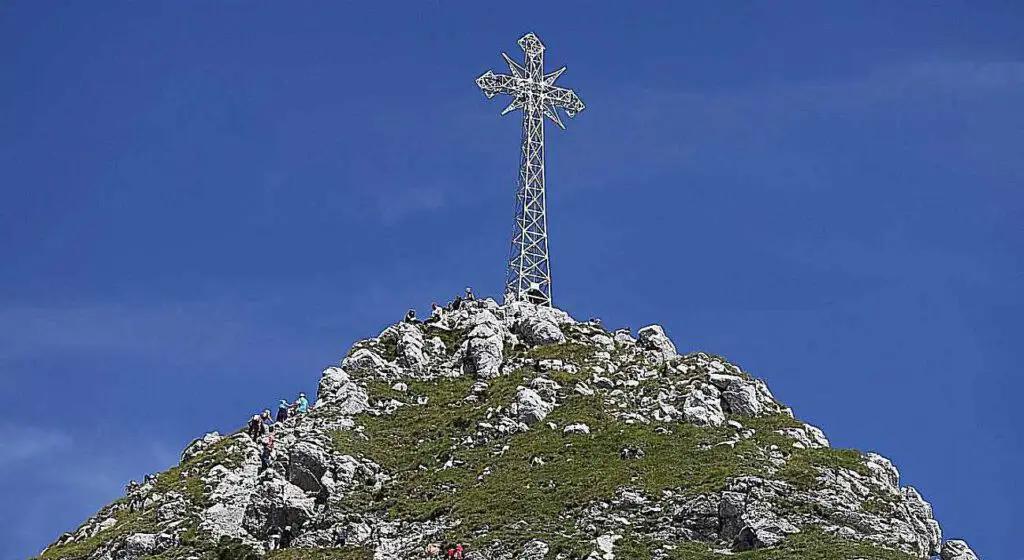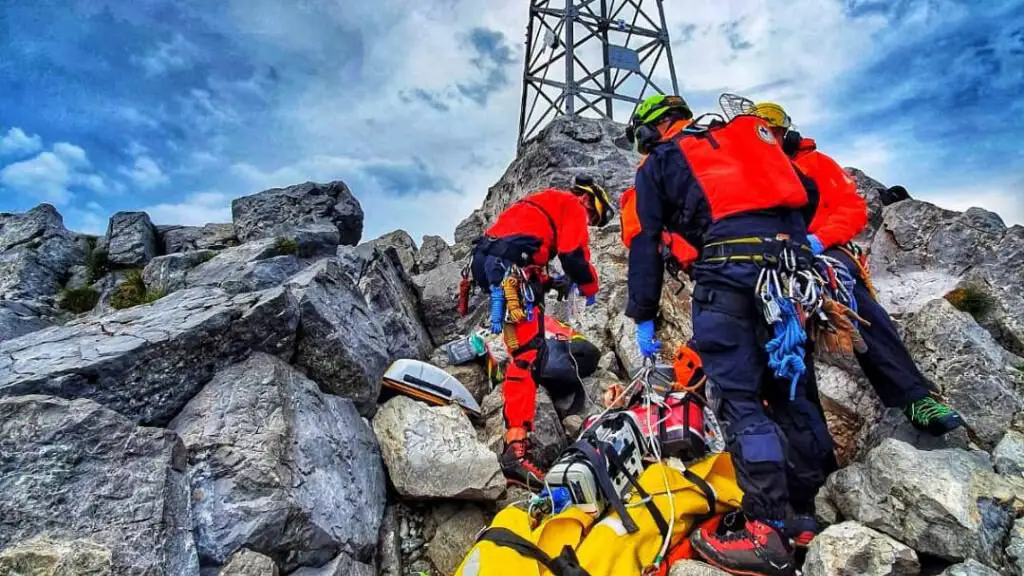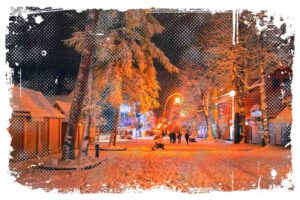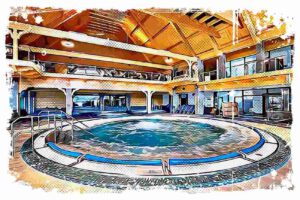The Great Giewont has been home to a cross for over 120 years, attracting tourists and pilgrims and witnessing several tragedies. But who put it there and why?

On August 19, 1901, nearly 300 people gathered near the top of the Great Giewont, most of them dressed in traditional Highlander costumes. The priest Wladyslaw Bandurski from Krakow, the future chaplain of the Polish legions, arrived to consecrate the 15-meter high metal cross that has become the symbol of Zakopane and the Tatra Mountains. So, how and why did the highlanders put up the cross?
The Story Behind the Cross

The metal cross on the top of the Great Giewont (1894 m above sea level) in the Giewont Massif was erected on August 19, 1901 as a tribute of the Zakopane parishioners to the 1900th anniversary of the birth of Jesus Christ. The initiative came from the then parish priest of Zakopane, Kazimierz Kaszelewski.
When constructing the cross, the highlanders were inspired by Italian towns that erected crosses on mountain peaks in the jubilee year – 1900. They conducted tests to determine the appropriate height of the cross to be visible from Zakopane. A 10.5 meter high model was made from wooden poles. The metal cross was manufactured by the Górecki factory in Cracow and delivered to Zakopane in segments by rail.
↳ Make sure to check out my guide to ALL attractions in Zakopane, so you don't overlook anything interesting: 66 Best Attractions in Zakopane 2023 – What to Do – Interesting Places
The cross stands at an impressive height of 17.5 meters, 2.5 meters of which are embedded in the rock. The arm of the cross is 5.5 meters long. The structure consists of 400 iron elements and weighs about 1,900 kilograms.
- You may also read: Trekking to the Highest Mountain Peaks Near Zakopane
The Journey of the Cross to the Summit
The parts of the cross were transported to Hala Kondratowa by horse-drawn carts, and from there they were carried to the top on people’s backs. The assembly process took 6 days and was personally supervised by Jozef Górecki.
At the intersection of the arms of the cross there is an inscription: „Jesu Christo Deo, restitutæ per ipsum salutis MCM” – „To Jesus Christ, God, on the 1900th anniversary of His Restoration of Salvation”.
On August 19, 1901, Rev. Canon Wladyslaw Bandurski from Krakow consecrated the cross during a mass in Giewont attended by about 300 people. Since then, the place has become a popular destination for numerous pilgrimages, and Pope John Paul II often mentioned it in his speeches.

However, I need to tell you that the Giewont cross also has a „dark side”. It poses a great danger during thunderstorms, as it attracts lightning and acts as a giant lightning rod. Being near the cross during a storm can lead to disaster. The first tragic accident occurred on August 19, 1937, when lightning struck during a pilgrimage, killing four people and injuring 13 others.
It is essential to descend from the summit during an approaching storm. There have been more.
- I think you should also read this article: Understanding the Risks – Tatra Mountains Death Statistics
A Challenging Team Effort

Work began in the fall of 1900, when the parish priest, a dozen highlanders, and Piatkiewicz, the climate commissioner, set out for the Great Giewont. Before reaching the summit, the group stopped at the last hut below the summit, where they collected two long poles. At the top, the men nailed the wooden elements together, forming a cross, and placed it in a sixty-centimeter hole, covering it with stones.
This trial cross was 10.5 meters high, and when the participants returned, they were thrilled to see it visible to the naked eye from Zakopane. Father Kaszlewski suggested that it could be bigger, and with this request he approached the contractor – Jozef Gorecki’s Artistic and Locksmith’s Works.
When the 17.5-meter metal cross was erected on the mountain in the late spring of 1901, Jakub Gąsienica Wawrytko, a renowned local stonemason and friend of Stefan Żeromski, and his helpers carved a deep, almost two-meter hole in the rock. But that wasn’t the hardest part. Transporting the 400 elements to the top was even more difficult.
In 1901, the placement of the cross on top of the mountain was an extremely difficult undertaking.
On June 16, 1901, a train with the ordered goods arrived at the Zakopane railway station. Two weeks later, the parish priest gathered about 250 people (some sources say it was twice as many) who loaded the disassembled cross onto 18 horse-drawn carts and went to the area of Kuznice and then to Great Giewont. Father Kaszlewski later told the press:
„After Mass, we set off for Kuźnice, having separated the iron into individual carts, which also hauled it wherever we could, i.e.: to the so-called 'Hell’. Here a division took place. All of them had to carry 400 kg of cement and twenty-odd cans of water in addition to the iron. Around 11 o’clock, we all found ourselves happily at the top and distributed the load. 10 cubic meters containing a cavity in the rock had previously been carved, which cost the two mountaineers 7 days of work. After a respite on the summit, everyone dispersed – only the factory owner Mr. Górecki with his fitter, myself, and 6 highlanders remained to fix the bottom of the cross in the rock. When we luckily succeeded, despite the rain, and when we filled the cavity with rocks and flooded the corners with cross-cement, we left the fitter on the mountain, who with 2 highlanders assembled the rest of the cross, which cost 6 days of work.„
On July 8, 1901, a cross – 15 meters high and 5.5 meters wide – was erected on the Great Giewont. The cost of making the cross, digging a hole in the rock and assembling it was 735 Rhenish gold. At the intersection of the arms of the cross, the inscription reads: Jesu Christo Deo, restitutæ per ipsum salutis MCM (Latin: Jesus Christ, God, on the 1900th anniversary of his restoration of salvation).
A Site of Pilgrimage and Tragedy

The area around the metal cross is incredibly dangerous during storms. Throughout its 120-year history, there have been several accidents, some of them fatal. In August 1937, a series of violent storms swept across central Europe, causing unprecedented destruction. Lightning caused fires and deaths, including a tragedy in the Tatra Mountains near the Cross.
On August 15, 1937, at about 12:00 p.m., dark clouds unexpectedly approached from above the Red Peaks and were periodically illuminated by lightning. A bolt of lightning struck the cross where 12 people were huddled. Three of them died instantly, and it was later discovered that they were not just tourists.
Is the Cross on Giewont a Lightning Magnet?

Occasionally, the media discusses the safety of the cross at Giewont. One of the worst tragedies at the site occurred on August 15, 1937, when lightning struck the cross while twelve people were nearby. Among the three who died instantly were a boy selling cakes and a folk singer, both present to earn money.
In 2019, five people died and 157 were injured in another incident at the same location. At the time, misyjne.pl featured Tomasz Rożek, who explained that it is not the cross, but Giewont itself that attracts lightning:
„Whether the cross is there or not has no effect on the frequency of storms and lightning there. It’s not that if it wasn’t there, storms would avoid Giewont, or a cloud would pass through there, but there would be no lightning. If anything attracts lightning, it is Giewont itself, being the highest elevation in the area”.
The news of the death of three people by lightning at noon on the 15th, on the summit of Giewont, under the cross, spread throughout Poland with a painful echo. Only one of them was a tourist. The other two victims were Jan Mróz, son of a well-known bagpiper from Poronin, also a bagpiper, and Kazimierz Bania, an 18-year-old boy, a cake seller.
The latter two were drawn to this beautiful peak, which towers over Zakopane, not by the charm of a Tatra excursion, nor by the desire to enjoy the beauty of the mountains in the midday sun – but by the everyday desire to earn money. (…) On this sad road we learn that on the top of Giewont there is something like a small town fair„. – Stach Willow reported in the Illustrated Daily Courier.
The Vanishing Cross of Giewont
Have you ever heard about the cross that sometimes disappears in Giewont? Well, it turns out that the reader who asked about it was right! The cross on Giewont sometimes disappears, and geographer Apoloniusz Rajwa has explained the phenomenon behind it.
The Optical Phenomenon
According to Rajwa, an expert on the Tatra Mountains, the phenomenon that makes the cross disappear on Giewont is the opposite of the fatamorgana that occurs in the desert. It is an optical illusion that occurs on hot, cloudless days when there are no clouds behind the peak of Giewont. The walls of Giewont heat up and the warm air rises, causing the steel openwork structure to become invisible.
Expert’s Experience
Apoloniusz Rajwa, who worked for many years at the High Mountain Meteorological Observatory on Kasprowy Wierch, has observed this phenomenon himself. He explains that the effect lasts for about two hours and can be seen on warm days in June. He further explains that the heated air particles vibrate and move upwards for several tens of meters, making it impossible to observe the cross.
„Observation is made impossible by this vibrating, heated and moving air. The first time this 'disappearance’ was brought to my attention by a colleague, and in fact, later on, my colleagues and I again observed the absence of the cross on Giewont under similar conditions,” says Rajwa.
So the next time you visit Giewont and the cross seems to be missing, don’t worry! It could just be the optical phenomenon that makes it disappear.
References:
- https://www.pap.pl/aktualnosci/news%2C1223305%2Czagadka-znikajacego-krzyza-na-giewoncie-rozwiazana.html
- https://ciekawostkihistoryczne.pl/2021/10/31/krzyz-na-wielkim-giewoncie/
- https://misyjne.pl/przerwa-artykul/dlaczego-na-giewoncie-jest-krzyz/




